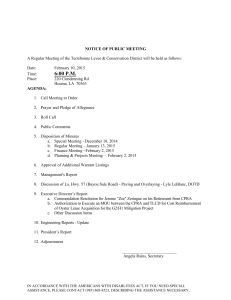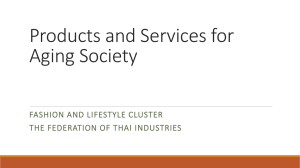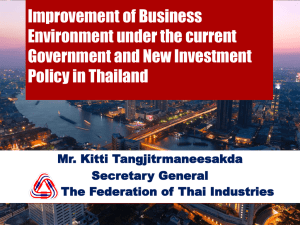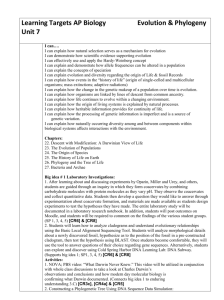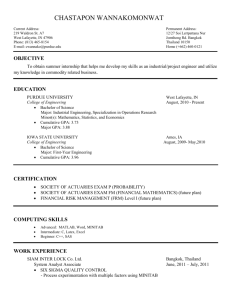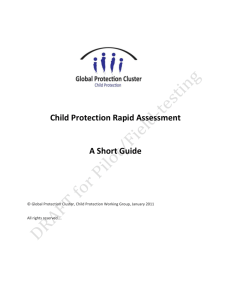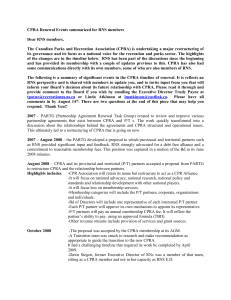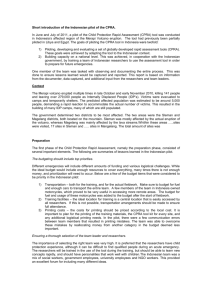Thailand ToR CP assessment CPRA Advisor ENG 2011
advertisement
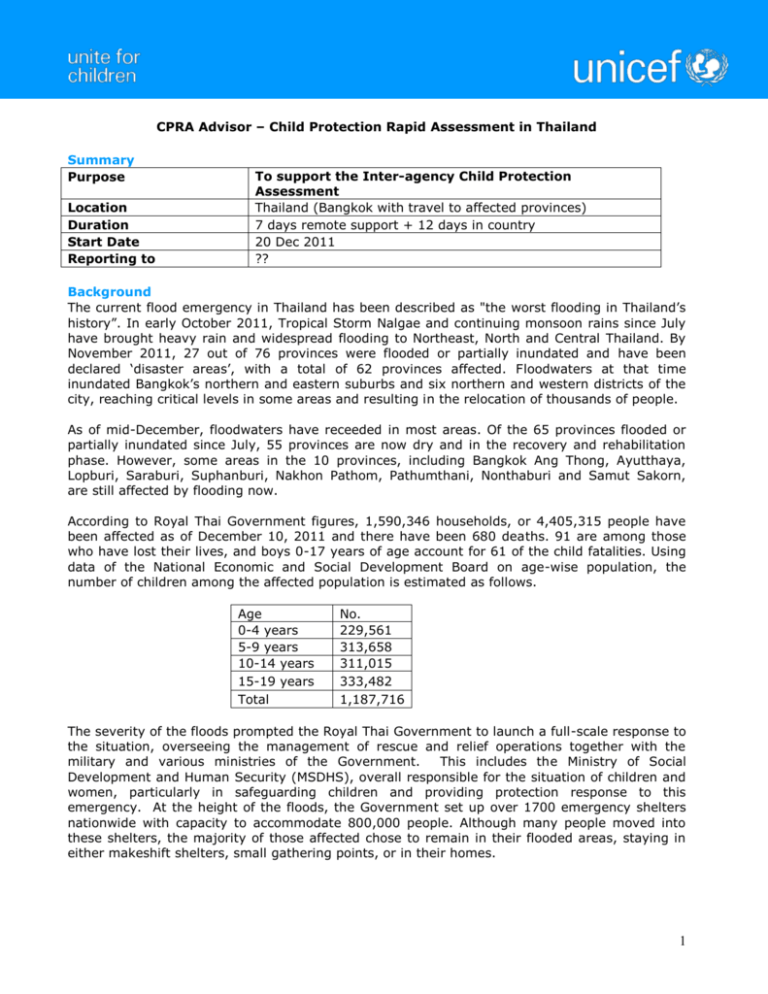
CPRA Advisor – Child Protection Rapid Assessment in Thailand Summary Purpose Location Duration Start Date Reporting to To support the Inter-agency Child Protection Assessment Thailand (Bangkok with travel to affected provinces) 7 days remote support + 12 days in country 20 Dec 2011 ?? Background The current flood emergency in Thailand has been described as "the worst flooding in Thailand’s history”. In early October 2011, Tropical Storm Nalgae and continuing monsoon rains since July have brought heavy rain and widespread flooding to Northeast, North and Central Thailand. By November 2011, 27 out of 76 provinces were flooded or partially inundated and have been declared ‘disaster areas’, with a total of 62 provinces affected. Floodwaters at that time inundated Bangkok’s northern and eastern suburbs and six northern and western districts of the city, reaching critical levels in some areas and resulting in the relocation of thousands of people. As of mid-December, floodwaters have receeded in most areas. Of the 65 provinces flooded or partially inundated since July, 55 provinces are now dry and in the recovery and rehabilitation phase. However, some areas in the 10 provinces, including Bangkok Ang Thong, Ayutthaya, Lopburi, Saraburi, Suphanburi, Nakhon Pathom, Pathumthani, Nonthaburi and Samut Sakorn, are still affected by flooding now. According to Royal Thai Government figures, 1,590,346 households, or 4,405,315 people have been affected as of December 10, 2011 and there have been 680 deaths. 91 are among those who have lost their lives, and boys 0-17 years of age account for 61 of the child fatalities. Using data of the National Economic and Social Development Board on age-wise population, the number of children among the affected population is estimated as follows. Age 0-4 years 5-9 years 10-14 years 15-19 years Total No. 229,561 313,658 311,015 333,482 1,187,716 The severity of the floods prompted the Royal Thai Government to launch a full-scale response to the situation, overseeing the management of rescue and relief operations together with the military and various ministries of the Government. This includes the Ministry of Social Development and Human Security (MSDHS), overall responsible for the situation of children and women, particularly in safeguarding children and providing protection response to this emergency. At the height of the floods, the Government set up over 1700 emergency shelters nationwide with capacity to accommodate 800,000 people. Although many people moved into these shelters, the majority of those affected chose to remain in their flooded areas, staying in either makeshift shelters, small gathering points, or in their homes. 1 Even though the IASC cluster system was not officially activated, the Protection Cluster was formed under the leadership of UNHCR. Similarly, a Child Protection Sub Cluster was set-up under the leadership of UNICEF to coordinate the child protection responses. With the floodwaters receding, the Royal Thai Government has established a structure for the coordination of the recovery phase, which it has signaled for a one year period. Although the Clusters, and thereby the CP sub-Cluster, are winding down the frequency of meetings, the members will continue to convene throughout the recovery phase to coordinate activities and transition back into the emergency preparedness work that was taking place prior to the flood emergency. Justification To date there has been no systematic collection of data specifically on child protection issues arising from the flooding through rapid assessments or similar. The assessments that were carried out during the initial phase of the flood response were mainly agency-specific and multisectoral. These led to the identification of priority response activities for members of the Clusters as well as the CP sub-Cluster. With the floodwater receding, however, there was recognition on behalf of CP sub-Cluster members that given the changing nature of the situation, an assessment of the protection risks for children needs to be conducted for the recovery phase. An inter-agency child protection assessment would provide actors with a necessary common reference point for the recovery phase in terms of identified child protection risks and priorities. It would also function as a bridge between the relief and recovery activities, including linkage with the longer term child protection systems strengthening work. An aspect of the child protection assessment would focus on an assessment of the child protection system’s capacity to respond to the needs and issues for children. The inter-agency child protection rapid assessment in flood affected provinces planned by the members of the Child Protection sub-Cluster in Thailand aims to: determine the scale of the needs and protection risks for children affected by the flooding; and to determine potential and actual capacities within the communities and service providers to respond to the existing risks and needs. With regards to the methodology for the child protection rapid assessment, a tool developed by the global CPWG will be used and adapted to the Thailand context. This assessment tool includes a few basic components: desk review, key informant interviews and direct observation. The aim is for the assessment findings to enable actors within the humanitarian community as well as the Government of Thailand to have a better understanding of the protection risks for children in the aftermath of the flooding, to identify appropriate responses to issues and concerns identified, as well as provide recommendations for strengthening child protection services. Objectives & Scope of Work The deployment of the assessment focal point from the Rapid Response Team (CPWG-Geneva) has been requested to support the CPRA in Thailand. The overall purpose of this assignment is to provide supporting during planning and direct leadership in the process of analysis interpretation and report writing of the child protection rapid assessment in Thailand. While the assessment 2 focal point will have an overall responsibility to ensure that all assessment activities are implemented according to the assessment plan, the CPRA advisor will provide technical support throughout the process as well as hands-on support during analysis, interpretation and report writing. The following tasks are expected from the CPRA advisor: - Participate in discussions on design and adaptation of the CP rapid assessment; Provide support in adapting and developing training material for the training of assessors and team leaders; Support the assessment focal point and the CPWG member representatives in adapting the data management tool; Provide hands-on support to CPWG members in the process of analysis, interpretation and report writing; Support CPWG members in provision of inputs to the HCT workshop (planned for ….) Expected background and Experience The following requirements are necessary for the CPRA advisor: - Advanced university degree in social sciences or related technical field; High level of competency in in child protection issues and rapid assessment methodologies and familiarity with the inter-agency CPWG CPRA toolkit; Superior analytical, conceptual and writing skills; Good command of both written and spoken English; Knowledge of the Thai context is an asset. Guidance The CPRA advisor will work closely with selected CP Assessment Working Group members of the Child Protection sub-Cluster in Thailand. General Conditions The CPRA advisor is expected to have reliable access to internet during the preparation process S/he is also expected to be able to travel to Thailand for the period between 21 and 31 January 2012. It is acknowledged that the CPRA advisor may not be available to support the process from January 7th to 21st 2012. 3
